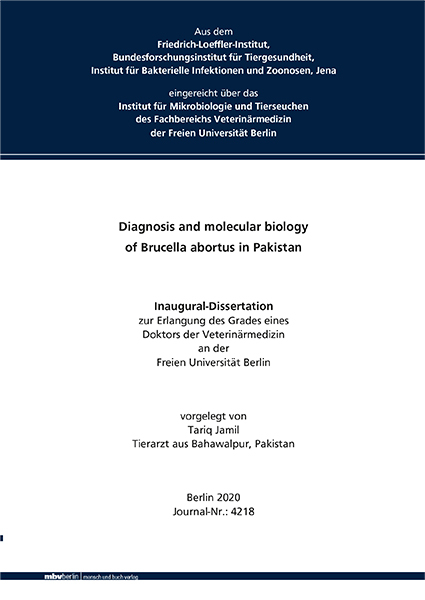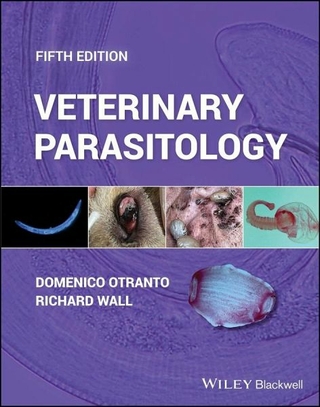
Diagnosis and molecular biology of Brucella abortus in Pakistan
Seiten
2020
|
1. Aufl.
Mensch & Buch (Verlag)
978-3-96729-076-9 (ISBN)
Mensch & Buch (Verlag)
978-3-96729-076-9 (ISBN)
- Keine Verlagsinformationen verfügbar
- Artikel merken
Diagnose und Molekularbiologie von Brucella abortus in Pakistan
Die Brucellose ist eine weltweit auftretende Zoonose und bleibt ein anhaltendes Problem bei Hauswiederkäuern in Pakistan. Sie wird hauptsächlich von B. abortus und teilweise von B. melitensis verursacht. Beim Menschen besteht ein Zusammenhang mit beruflicher Exposition oder dem Konsumieren von kontaminierter, nicht pasteurisierter Milch. Brucellose-Impfungen werden bei Wiederkäuern in Pakistan noch selten durchgeführt. Obwohl sich die wissenschaftliche Gemeinschaft intensiv mit Brucelloseforschung befasst, sind sich Bauern, Ärzte und Tierärzte der Krankheit und des zoonotischen Risikos infizierter Tiere nicht bewusst.
Insgesamt wurden 828 Seren von Büffeln (409) und Rindern (419), 1000 Seren kleiner Wiederkäuer (500 Schafe und 500 Ziegen) und 181 Hundeseren von organisierten Tierfarmen bzw. von streunenden Hunden und Arbeitshunden, die in engem Kontakt mit Wiederkäuern standen, aus verschiedenen Orten im Punjab, Pakistan gesammelt. Die Seren wurden mit RBPT, iELISA (für B. abortus und B. melitensis) und SAT (für B. canis) untersucht und gattungs-(Brucella) sowie speziesspezifischer (B. abortus und B. melitensis) real-time PCR unterzogen. Bei Rindern wurde eine Gesamtseroprävalenz von 3,9% gefunden und B. abortus als ursächlich beteiligtes Bakterium identifiziert. Bei kleinen Wiederkäuern betrug die Prävalenz 5,1%, aber die beteiligte Brucella spp. konnte nicht identifiziert werden, da alle untersuchten Seren in der real-time PCR negativ waren. Hunde litten zu 4,9% an Wiederkäuerbrucellose (B. abortus), was durch die real-time PCR bestätigt wurde. Insgesamt 37,6% der mittels SAT untersuchten Hunde waren positiv für Hunde-Brucellose (B. canis).
Die für Rinder identifizierten Risikofaktoren waren Standort und Spezies (Büffel); für kleine Wiederkäuer Standort, Alter (>4 Jahre), Gebährstatus (v1), Tierrasse und Fortpflanzungsstörungen sowie für Hunde Standort, Alter (≥1 Jahre) und schwacher Körperzustand für B. canis-Infektionen und das Vorhandensein von Wunden für B. abortus-Infektionen. Diese Risikofaktoren waren signifikant mit höheren Odds-ratio Werten für Brucellose korreliert. Standort und Alter waren in allen Studien die häufigsten Risikofaktoren.
Im Rahmen der vorliegenden Studie hat sich gezeigt, dass Brucellose in organisierten Tierfarmen im Punjab, Pakistan ein anhaltendes Problem darstellt. B. abortus ist dabei der am häufigsten identifizierten Erreger. Eine alarmierend hohe Prävalenz von Hunde-Brucellose verursacht durch B. canis wurde festgestellt. Robuste, billigere und zuverlässigere Diagnosetests sind sowohl für Brucellen mit glattem und rauem LPS erforderlich, um den Anforderungen der örtlichen Situation gerecht zu werden. Die Anzüchtung der Brucellen ist in jedem Fall erforderlich, um DNA von hoher Qualität für weitere molekulare und vergleichende epidemiologische Studien zu gewinnen. Schulungen und andere Maßnahmen zur Verbreitung von Wissen über die Krankheit, Maßnahmen zur Vermittlung von Grundlagen der biologischen Sicherheit, Aufklärungsprogramme und die Umsetzung dieser Maßnahmen in landwirtschaftlichen Betrieben und auf Laborebene sind unabdingbare Voraussetzungen für eine effiziente künftige Bekämpfung der Brucellose in Pakistan. Brucellosis is a zoonotic disease worldwide and remains a persistent problem in domestic ruminants in Pakistan. It is mainly caused by B. abortus and to some extent by B. melitensis. In humans, it is related to either professionals after accidental exposure or to the general public via consumption of contaminated unpasteurized milk. Brucellosis vaccination is rarely practiced in the ruminants of the country, yet. Although the scientific community is engaged in brucellosis research, animal holders, veterinarians and physicians are not aware of the disease and the zoonotic risk posed by infected animals.
A total of 828 bovine (409 buffaloes and 419 cattle), 1,000 small ruminant (500 sheep and 500 goats) and 181 dog sera were collected from organized livestock farms and stray and working dogs in close contact to ruminants from various locations across Punjab, Pakistan, respectively. The sera were subjected to RBPT, iELISA (for B. abortus and B. melitensis) and SAT (for B. canis) and genus- (Brucella) and species-specific (B. abortus and B. melitensis) real-time PCR. In bovines, an overall seroprevalence of 3.9% was found and B. abortus was identified as the etiological agent. In small ruminants, a prevalence of 5.1% was found but the causative bacteria could not be identified, as all investigated sera were negative by real-time PCR. A total of 4.9% of dogs had livestock brucellosis (B. abortus) confirmed by real-time PCR, whereas 37.6% were positive for canine brucellosis (B. canis) using SAT.
Risk factors identified for bovines were location and species (buffaloes), for small ruminants location, age (>4years), parity status (>1), breed of the animal and reproductive disorders and for dogs location, age (≥1 years) and a weak body condition (for B. canis infection) and the presence of wounds (for B. abortus infection). These risk factors were significantly associated with brucellosis with higher risk odds. Thus, location and age were the most associated risk factors in all studies.
It was shown that brucellosis is a persisting problem at organized livestock farms in Punjab, Pakistan. B. abortus is the disease-causing agent. An alarmingly high prevalence of canine brucellosis caused by B. canis was detected. Robust, cheaper, and more reliable diagnostic tests are needed for both, smooth and rough-LPS Brucella spp., to meet the needs of the local situation. Isolation of the bacteria at any case will be needed for preparation of high-quality DNA for advanced molecular and comparative epidemiological studies. Nevertheless, advanced training, knowledge about the disease dissemination, biosafety and biosecurity measures, awareness programs and implementation of these measures at farms and laboratory levels are obvious needs to combat brucellosis in the future in Pakistan.
Die Brucellose ist eine weltweit auftretende Zoonose und bleibt ein anhaltendes Problem bei Hauswiederkäuern in Pakistan. Sie wird hauptsächlich von B. abortus und teilweise von B. melitensis verursacht. Beim Menschen besteht ein Zusammenhang mit beruflicher Exposition oder dem Konsumieren von kontaminierter, nicht pasteurisierter Milch. Brucellose-Impfungen werden bei Wiederkäuern in Pakistan noch selten durchgeführt. Obwohl sich die wissenschaftliche Gemeinschaft intensiv mit Brucelloseforschung befasst, sind sich Bauern, Ärzte und Tierärzte der Krankheit und des zoonotischen Risikos infizierter Tiere nicht bewusst.
Insgesamt wurden 828 Seren von Büffeln (409) und Rindern (419), 1000 Seren kleiner Wiederkäuer (500 Schafe und 500 Ziegen) und 181 Hundeseren von organisierten Tierfarmen bzw. von streunenden Hunden und Arbeitshunden, die in engem Kontakt mit Wiederkäuern standen, aus verschiedenen Orten im Punjab, Pakistan gesammelt. Die Seren wurden mit RBPT, iELISA (für B. abortus und B. melitensis) und SAT (für B. canis) untersucht und gattungs-(Brucella) sowie speziesspezifischer (B. abortus und B. melitensis) real-time PCR unterzogen. Bei Rindern wurde eine Gesamtseroprävalenz von 3,9% gefunden und B. abortus als ursächlich beteiligtes Bakterium identifiziert. Bei kleinen Wiederkäuern betrug die Prävalenz 5,1%, aber die beteiligte Brucella spp. konnte nicht identifiziert werden, da alle untersuchten Seren in der real-time PCR negativ waren. Hunde litten zu 4,9% an Wiederkäuerbrucellose (B. abortus), was durch die real-time PCR bestätigt wurde. Insgesamt 37,6% der mittels SAT untersuchten Hunde waren positiv für Hunde-Brucellose (B. canis).
Die für Rinder identifizierten Risikofaktoren waren Standort und Spezies (Büffel); für kleine Wiederkäuer Standort, Alter (>4 Jahre), Gebährstatus (v1), Tierrasse und Fortpflanzungsstörungen sowie für Hunde Standort, Alter (≥1 Jahre) und schwacher Körperzustand für B. canis-Infektionen und das Vorhandensein von Wunden für B. abortus-Infektionen. Diese Risikofaktoren waren signifikant mit höheren Odds-ratio Werten für Brucellose korreliert. Standort und Alter waren in allen Studien die häufigsten Risikofaktoren.
Im Rahmen der vorliegenden Studie hat sich gezeigt, dass Brucellose in organisierten Tierfarmen im Punjab, Pakistan ein anhaltendes Problem darstellt. B. abortus ist dabei der am häufigsten identifizierten Erreger. Eine alarmierend hohe Prävalenz von Hunde-Brucellose verursacht durch B. canis wurde festgestellt. Robuste, billigere und zuverlässigere Diagnosetests sind sowohl für Brucellen mit glattem und rauem LPS erforderlich, um den Anforderungen der örtlichen Situation gerecht zu werden. Die Anzüchtung der Brucellen ist in jedem Fall erforderlich, um DNA von hoher Qualität für weitere molekulare und vergleichende epidemiologische Studien zu gewinnen. Schulungen und andere Maßnahmen zur Verbreitung von Wissen über die Krankheit, Maßnahmen zur Vermittlung von Grundlagen der biologischen Sicherheit, Aufklärungsprogramme und die Umsetzung dieser Maßnahmen in landwirtschaftlichen Betrieben und auf Laborebene sind unabdingbare Voraussetzungen für eine effiziente künftige Bekämpfung der Brucellose in Pakistan. Brucellosis is a zoonotic disease worldwide and remains a persistent problem in domestic ruminants in Pakistan. It is mainly caused by B. abortus and to some extent by B. melitensis. In humans, it is related to either professionals after accidental exposure or to the general public via consumption of contaminated unpasteurized milk. Brucellosis vaccination is rarely practiced in the ruminants of the country, yet. Although the scientific community is engaged in brucellosis research, animal holders, veterinarians and physicians are not aware of the disease and the zoonotic risk posed by infected animals.
A total of 828 bovine (409 buffaloes and 419 cattle), 1,000 small ruminant (500 sheep and 500 goats) and 181 dog sera were collected from organized livestock farms and stray and working dogs in close contact to ruminants from various locations across Punjab, Pakistan, respectively. The sera were subjected to RBPT, iELISA (for B. abortus and B. melitensis) and SAT (for B. canis) and genus- (Brucella) and species-specific (B. abortus and B. melitensis) real-time PCR. In bovines, an overall seroprevalence of 3.9% was found and B. abortus was identified as the etiological agent. In small ruminants, a prevalence of 5.1% was found but the causative bacteria could not be identified, as all investigated sera were negative by real-time PCR. A total of 4.9% of dogs had livestock brucellosis (B. abortus) confirmed by real-time PCR, whereas 37.6% were positive for canine brucellosis (B. canis) using SAT.
Risk factors identified for bovines were location and species (buffaloes), for small ruminants location, age (>4years), parity status (>1), breed of the animal and reproductive disorders and for dogs location, age (≥1 years) and a weak body condition (for B. canis infection) and the presence of wounds (for B. abortus infection). These risk factors were significantly associated with brucellosis with higher risk odds. Thus, location and age were the most associated risk factors in all studies.
It was shown that brucellosis is a persisting problem at organized livestock farms in Punjab, Pakistan. B. abortus is the disease-causing agent. An alarmingly high prevalence of canine brucellosis caused by B. canis was detected. Robust, cheaper, and more reliable diagnostic tests are needed for both, smooth and rough-LPS Brucella spp., to meet the needs of the local situation. Isolation of the bacteria at any case will be needed for preparation of high-quality DNA for advanced molecular and comparative epidemiological studies. Nevertheless, advanced training, knowledge about the disease dissemination, biosafety and biosecurity measures, awareness programs and implementation of these measures at farms and laboratory levels are obvious needs to combat brucellosis in the future in Pakistan.
| Erscheinungsdatum | 16.04.2021 |
|---|---|
| Verlagsort | Berlin |
| Sprache | englisch |
| Maße | 148 x 210 mm |
| Themenwelt | Veterinärmedizin ► Allgemein |
| Veterinärmedizin ► Klinische Fächer ► Parasitologie | |
| Schlagworte | Brucella abortus • Brucella canis • Diagnostic techniques • Dogs • genomics • Goats • livestock • Pakistan • Proteomics • Reviews • Sheep • Taxonomy • Zoonoses |
| ISBN-10 | 3-96729-076-X / 396729076X |
| ISBN-13 | 978-3-96729-076-9 / 9783967290769 |
| Zustand | Neuware |
| Informationen gemäß Produktsicherheitsverordnung (GPSR) | |
| Haben Sie eine Frage zum Produkt? |
Mehr entdecken
aus dem Bereich
aus dem Bereich
Buch | Spiralbindung (2023)
Schlütersche (Verlag)
179,00 €


